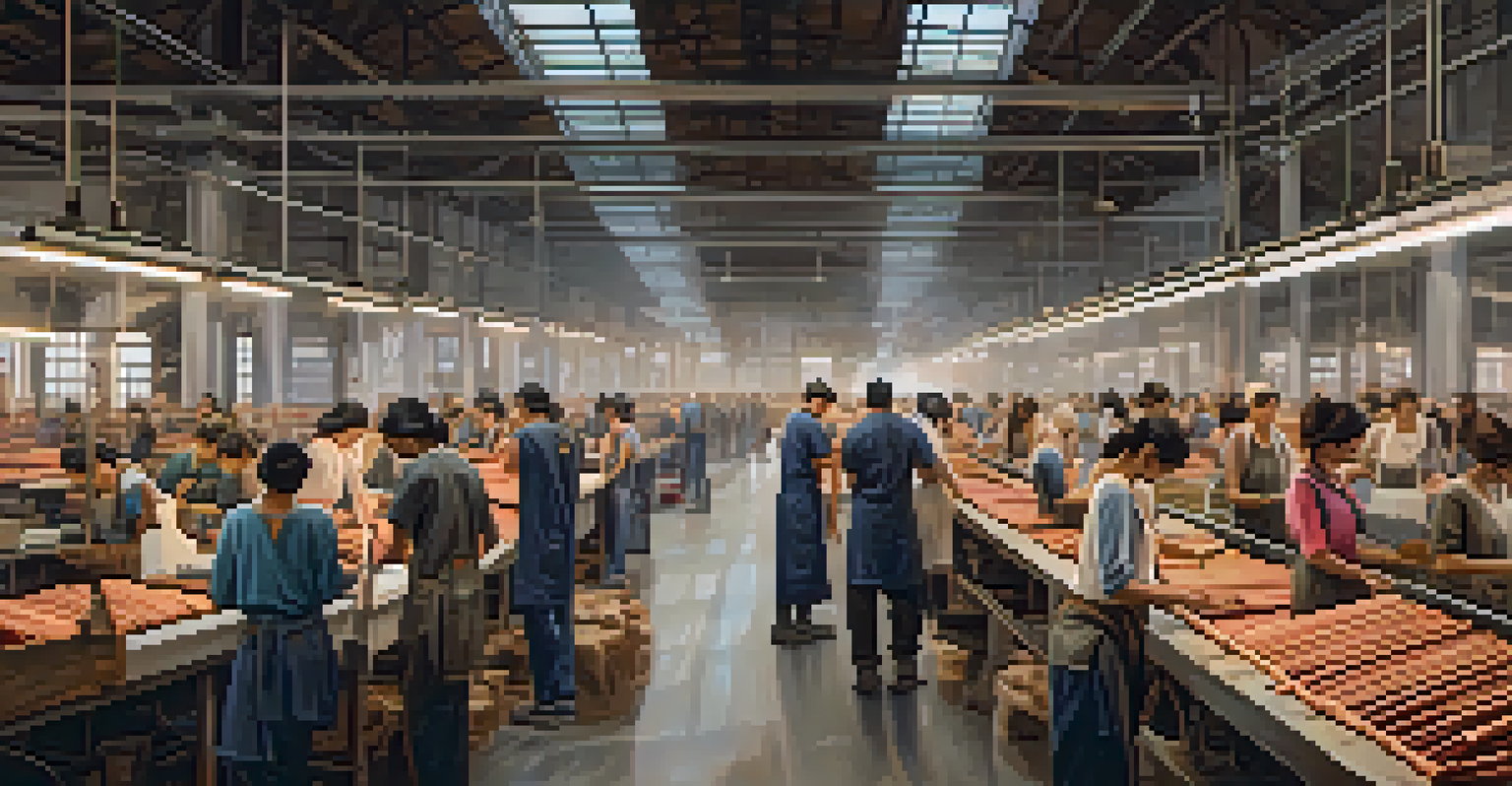Social Consequences of Fast Fashion: Labor and Ethics Issues

Understanding Fast Fashion: A Brief Overview
Fast fashion refers to the rapid production of inexpensive clothing that reflects the latest trends. Brands like Zara and H&M thrive on this model, offering new styles multiple times a year. While this approach meets consumer demand for variety, it often comes at a significant social cost, particularly in labor practices.
Fast fashion is a significant contributor to the exploitation of workers in developing countries.
The fast fashion industry is notorious for its reliance on cheap labor, primarily in developing countries. Workers, often women and children, face incredibly long hours and minimal pay. This business model prioritizes profit over the well-being of individuals, raising critical ethical concerns.
As consumers, we play a crucial role in this cycle. The convenience and affordability of fast fashion make it tempting to overlook the hidden costs behind each garment. Understanding this backdrop is essential for examining the broader social implications.
Labor Exploitation in the Fast Fashion Industry
A significant issue within fast fashion is labor exploitation, where workers endure harsh conditions for meager wages. Many factory workers are paid less than a living wage, often working in unsafe environments. Reports of sweatshops reveal cramped conditions, lack of breaks, and even child labor.

For instance, the tragic collapse of the Rana Plaza building in Bangladesh in 2013, which housed several garment factories, highlighted the extreme risks workers face daily. Over 1,100 lives were lost, sparking global outrage and prompting calls for reform. Yet, despite these tragedies, many brands still prioritize low costs over ethical labor practices.
Fast Fashion's Ethical Dilemma
The fast fashion industry often exploits cheap labor in developing countries, raising significant ethical concerns.
The cycle of exploitation continues as consumers demand ever-cheaper clothing. With each purchase of a low-priced item, we inadvertently support a system that devalues human life. Recognizing this connection is the first step towards demanding better practices in the industry.
The Impact of Fast Fashion on Local Economies
Fast fashion not only affects individual workers but also has broader implications for local economies in developing nations. While it may create jobs, these positions are often unstable and exploitative. The focus on mass production and low-cost goods can undermine local businesses that cannot compete with large multinational corporations.
The fashion industry is at a crossroads. The fast fashion model has proven to be unsustainable, both ethically and environmentally.
For example, local artisans and craftsmen may find it increasingly difficult to sustain their livelihoods as fast fashion brands flood the market with cheap alternatives. This shift can lead to a loss of traditional crafts and a decline in cultural heritage, as communities shift from sustainable practices to mass production.
Furthermore, reliance on the fast fashion model can create economic instability. If a brand pulls out of a country or a factory closes, it can leave workers and their families in dire situations. This volatility highlights the need for more sustainable and ethical approaches to clothing production.
Environmental Consequences of Fast Fashion
While the focus here is on labor and ethics, we cannot ignore the environmental consequences of fast fashion. The production processes are often resource-intensive, leading to significant waste and pollution. From water usage to chemical runoff, the environmental footprint is staggering.
Moreover, fast fashion encourages a culture of disposability, where consumers are conditioned to discard clothes after a few wears. This behavior exacerbates landfill issues, as textiles can take years to decompose. The environmental degradation caused by this cycle poses a grave concern for future generations.
Environmental Damage from Fast Fashion
The production and disposal practices of fast fashion contribute to severe environmental degradation and waste.
By acknowledging the interconnectedness of labor practices and environmental impacts, we can better understand the full scope of fast fashion's consequences. It’s a complex web, where ethical sourcing and sustainability go hand in hand.
Ethical Consumerism: Making Informed Choices
Ethical consumerism is a powerful way to combat the negative impacts of fast fashion. By choosing to support brands that prioritize fair labor practices and sustainable production methods, consumers can drive change. This shift requires us to be informed and intentional about our buying habits.
For example, brands like Everlane and Patagonia are known for their transparency and commitment to ethical practices. By opting for these companies, consumers can help support better working conditions and environmentally friendly practices. This conscious decision-making can lead to a ripple effect in the industry.
Additionally, second-hand shopping and thrift stores are becoming more popular as alternatives to fast fashion. These options not only reduce waste but also support local economies while promoting a more sustainable approach to fashion.
Advocacy and the Role of NGOs
Non-governmental organizations (NGOs) play a vital role in advocating for labor rights and ethical practices in the fashion industry. Organizations like Fair Trade and the Ethical Trading Initiative work to promote fair wages, safe working conditions, and responsible sourcing practices. Their efforts have led to increased awareness and pressure on brands to improve their labor practices.
Through campaigns, reports, and collaborations, NGOs hold brands accountable for their actions. They provide resources and support for workers, empowering them to advocate for their rights. This advocacy is crucial in creating lasting change within the industry.
Shift Toward Ethical Consumerism
Supporting brands that prioritize ethical practices and sustainable production can drive positive change in the fashion industry.
Engaging with these organizations can also influence consumer behavior. By supporting NGOs, individuals can contribute to a larger movement that pushes for systemic change, ensuring that the voices of workers are heard and valued.
The Future of Fashion: Toward a Sustainable Model
As we look to the future, the fashion industry is at a crossroads. The fast fashion model has proven to be unsustainable, both ethically and environmentally. However, there is a growing movement toward sustainable fashion that prioritizes ethical practices, fair labor, and environmental stewardship.
Innovative brands are emerging, focusing on slow fashion, which emphasizes quality over quantity. This shift encourages consumers to invest in timeless pieces rather than fleeting trends. By prioritizing sustainability, these brands aim to create a more equitable and environmentally friendly industry.

Ultimately, the future of fashion depends on consumer choices and advocacy. By demanding change and supporting ethical brands, we can pave the way for a fashion industry that respects people and the planet. Together, we can reshape the narrative around fashion and its impact on society.